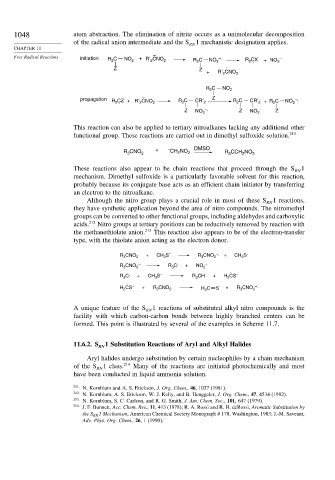Page 1064 - Advanced Organic Chemistry Part A - Structure and Mechanisms, 5th ed (2007) - Carey _ Sundberg
P. 1064
1048 atom abstraction. The elimination of nitrite occurs as a unimolecular decomposition
of the radical anion intermediate and the S 1 mechanistic designation applies.
RN
CHAPTER 11
–
Free Radical Reactions initiation R 2 C NO 2 + R′ 2 CNO 2 R 2 C NO 2 –. R 2 CX + NO 2 –
.
.
Z Z
+ R′ 2 CNO 2
R 2 C NO 2
– Z
propagation R 2 CZ + R′ 2 CNO 2 R 2 C CR′ 2 R 2 C CR′ 2 + R 2 C NO 2 –.
.
Z NO 2 –. Z NO 2 Z
This reaction can also be applied to tertiary nitroalkanes lacking any additional other
functional group. These reactions are carried out in dimethyl sulfoxide solution. 211
R CNO 2 + – CH NO 2 DMSO R CCH NO 2
2
3
3
2
These reactions also appear to be chain reactions that proceed through the S RN 1
mechanism. Dimethyl sulfoxide is a particularly favorable solvent for this reaction,
probably because its conjugate base acts as an efficient chain initiator by transferring
an electron to the nitroalkane.
Although the nitro group plays a crucial role in most of these S RN 1 reactions,
they have synthetic application beyond the area of nitro compounds. The nitromethyl
groups can be converted to other functional groups, including aldehydes and carboxylic
acids. 212 Nitro groups at tertiary positions can be reductively removed by reaction with
the methanethiolate anion. 213 This reaction also appears to be of the electron-transfer
type, with the thiolate anion acting as the electron donor.
+ CH 3 S – –. + CH 3 S .
R 3 CNO 2 R 3 CNO 2
–. . –
R 3 CNO 2 R 3 C + NO 2
.
R 3 C . + CH 3 S – R 3 CH + H 2 CS –
.
H 2 CS – + R 3 CNO 2 H 2 C S + R 3 CNO 2 –.
A unique feature of the S RN 1 reactions of substituted alkyl nitro compounds is the
facility with which carbon-carbon bonds between highly branched centers can be
formed. This point is illustrated by several of the examples in Scheme 11.7.
11.6.2. S 1 Substitution Reactions of Aryl and Alkyl Halides
RN
Aryl halides undergo substitution by certain nucleophiles by a chain mechanism
of the S 1 class. 214 Many of the reactions are initiated photochemically and most
RN
have been conducted in liquid ammonia solution.
211 N. Kornblum and A. S. Erickson, J. Org. Chem., 46, 1037 (1981).
212
N. Kornblum, A. S. Erickson, W. J. Kelly, and B. Henggeler, J. Org. Chem., 47, 4534 (1982).
213 N. Kornblum, S. C. Carlson, and R. G. Smith, J. Am. Chem. Soc., 101, 647 (1979).
214
J. F. Bunnett, Acc. Chem. Res., 11, 413 (1978); R. A. Rossi and R. H. deRossi, Aromatic Substitution by
the S RN 1 Mechanism, American Chemical Society Monograph # 178, Washington, 1983; J.-M. Saveant,
Adv. Phys. Org. Chem., 26, 1 (1990).

